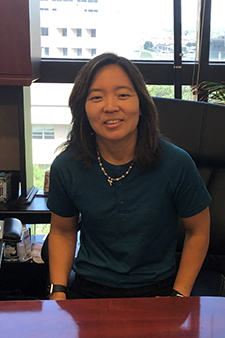Research Interests
The research interests of my group are broadly defined in the area of biosynthesis and mode of action of natural products and is supported by several project directions:
- Biosynthesis of the anti-tumor agent azinomycin and its applications in gene therapy
- Biosynthesis of cycloterpenals and its relatives, natural products produced by the milk protein betalactoglobulin, including cycloretinal and A2E linked to causing age-related macular degeneration
- Developing biochemical and genetic methods to activate biosynthetic pathways that are silent within their respective genomes
Nature greatly influences our research interests. Secondary metabolites (natural products), for example, are compounds that are found only in specific organisms and are an expression of the individuality of species. Indeed, at least 60% of all small molecule drugs on the market today are either natural products or have been derived from natural product leads.
The azinomycins are anti-tumor antibiotics isolated from the culture broths of the terrestrial microorganism, Streptomyces sahachiroi. Their biological activity appears to reside in their ability to covalently alkylate and subsequently cross-link double stranded DNA (binding of azinomycin to DNA shown below).
Our research group is actively characterizing the biosynthetic genes of this pathway, which involves a variety of techniques and strategies including: cloning and overexpression of genes, disruption/knockout of genes, enzymology, as well as chemical synthesis/isotopic labeling studies. Functional characterization of the genes of the pathway will not only shed light on the mechanism of azabicycle formation but will also pave the way for genetic engineering of the pathway and the development of new therapeutic methodologies.
We have also been investigating the biosynthesis and cellular effects of cycloterpenals and their derivatives. Cycloretinal (all-trans retinal dimer), a representative member of this family of natural products is attributed to causing age-related macular degeneration (AMD). AMD is the leading cause of blindness in adults over the age of 50 that can lead to the loss of central vision. One of the most common early characteristic features of AMD (the dry form) is the accumulation of yellow deposits in the eye called drusen. A more severe form of the disease, the wet form, is characterized by neovascularization (abnormal blood vessel formation).
Cycloretinal is a non-degradable, toxic byproduct of the visual cycle. Photochemical activation of the metabolite leads to oxidative damage of the retinal pigment epithelium and adjacent photoreceptor cells. Biochemical evidence from our lab has recently revealed that beta-lactoglobulin (BLG), the principal whey protein in milk, biosynthesizes the lipofuscin cycloretinal (all-trans retinal dimer). The protein survives the pasteurization process, is acid stable and a large fraction of the protein is transported intact through the blood stream (as supported by rabbit studies). Proteomic studies performed by Crabb and co-workers have shown that the protein is present in drusen.
Our research group aims to study the role of beta-lactoglobulin in cycloretinal synthesis in the eye as an environmental (dietary), non-genetic contributor of AMD. This involves tracking BLG in the eye, monitoring the formation of cycloretinal, and elucidating the mechanism of cycloretinal formation. Research strategies include: chemical synthesis, enzymology, fluorescence/confocal microscopy, PET imaging, dual modality OCT/fluorescence lifetime imaging.
Educational Background
- B. S., 1992, University of Hawaii
- Ph. D., 1998, The Johns Hopkins University
- Howard Hughes Postdoctoral Fellow of the Life Sciences Foundation, 2002, The Scripps Research Institute
Awards & Honors
- Research Corporation Innovation Award 2003
- Sarah and Aldoph Roseman Achievement Award
- NIEHS Pilot Grant Awardee
- Conocco Phillips Awardee
- American Cancer Society Scholar 2007
- "Rising Star" ACS PROGRESS, Dreyfus Lectureship Award 2008
Selected Publications
Perveen, I., Johnson, B. A., Gowda, V., Foley, B., Okezie, S., O’Brien, M., and Watanabe, C. M. H. “Catabolism of the Lipfuscin Cycloretinal by MsP1,” Biochemistry 2022, 61, 2560-2567; Cover Feature.
Perveen, I., Johnson, B. A., Gowda, V., Foley, B., and Watanabe, C. M. H. 2022 (Texas A&M University), USA, Patent Provisional 63/414,020.
Li, Y. L. (P); Washburn, L. A. (G).; Watanabe, C. M. H. “Thioester Capture Strategy for the Identification of Nonribosomal Peptide and Polyketide Intermediates,” 2022, Methods in Molecular Biology, accepted.
Washburn, L. A.; Nepal, K. K.; Watanabe, C. M. H. "A Capture Strategy for the Identification of Thio-Templated Metabolites," ACS Chem. Biol. 2021, 16, 1737-1744.
Bradley, N. P.; Washburn, L. A.; Christov, P. P.; Watanabe, C. M. H.; Eichman, B. F."Escherichia coli YcaQ is a DNA Glycosylase that Unhooks DNA Interstrand Crosslinks," Nucleic Acid Res. 2020, 48, 7005-7017; Cover feature.
Kelly, G. T.; Washburn, L. A.; Watanabe, C. M. H. "The Fate of Molecular Oxygen in Azinomycin Biosynthesis," J. Org. Chem. 2019, 84, 2991-2996.
Gowda, V.; Foley, B.; Du, J.; Esteb, M.; Watanabe, C. M. H. "Biocatalysis with the Milk Protein ß-lactoglobulin: Promoting Retroaldol Cleavage of ß-Unsaturated Aldehydes," Org. Biomol. Chem. 2018, 16, 221-2213; Received news brief in C&EN.
Gowda, V.; Foulke-Abel, J.; Agbo, H.; Chae. J.; Watanabe, C. M. H. "Lipofuscin formation Catalyzed by the Milk Protein ß-Lactoglobulin: Lysines in Cycloretinal Synthesis," Biochemistry 2017, 56, 5715-5719.
Mori, S.; Simkhada, D.; Zhang, H. Erb, M. S.; Zhang, Y.; Williams, H.; Fedoseyenko, D.; Russell, W. K.; Kim, D.; Fleer, N.; Ealick, S. E.; Watanabe, C. M. H. "Polyketide Ring Expansion Mediated by a Thioesterase, Chain Elongation and Cyclization Domain in Azinomycin Biosynthesis: Characterization of AziB and AziG," Biochemistry 2016, 55, 704-714 (Full Paper).

